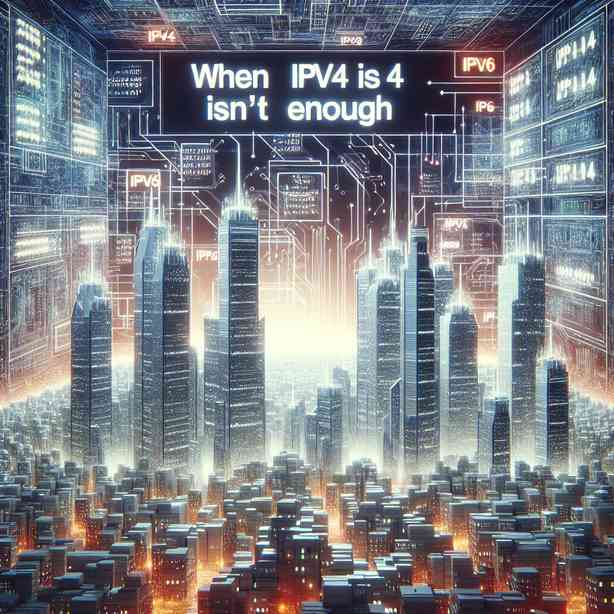
IPv4, or Internet Protocol version 4, has served as the backbone of internet communication for several decades. However, as our digital world expands, it’s becoming increasingly clear that IPv4 simply cannot meet the demands of modern internet usage. In this discussion, we will delve into the limitations of IPv4, explore the necessity for its successor, IPv6, and understand the broader implications this transition will have on the internet as we know it.
To begin with, let’s examine the fundamental structure of IPv4. This protocol uses a 32-bit address scheme, which allows for approximately 4.3 billion unique addresses. At first glance, that number seemed sufficient in the early days of the internet. However, with the exponential growth of internet-connected devices, mobile phones, smart home devices, and even sensors in agriculture and manufacturing, we have rapidly approached the limits of this address space.
The explosive growth of the internet and the rise of the Internet of Things (IoT) have significantly accelerated the depletion of IPv4 addresses. In 2011, the Internet Assigned Numbers Authority (IANA) officially announced that the growth of new IPv4 addresses had hit its limit, marking a significant moment in the history of the internet. This scarcity of available IPv4 addresses has led to the introduction of various workarounds, such as Network Address Translation (NAT), to help extend the usability of existing addresses. However, these solutions also come with their own set of complications, including increased complexity in network configuration and potential bottlenecks in communication.
One of the major downsides of relying on IPv4 is the fragmentation it causes in addressing. With NAT, multiple devices within the same local network can share a single public IP address. While this may seem like an ideal short-term solution, it introduces challenges in peer-to-peer communication, making it harder for devices to communicate directly over the internet. This is particularly problematic for applications that require end-to-end connectivity, such as voice over IP (VoIP) or real-time gaming.
Moreover, the security aspect of IPv4 is also a concern. The protocol was not designed with security in mind, leading to vulnerabilities that can be exploited by cybercriminals. As businesses and organizations increasingly prioritize data security, relying solely on IPv4 presents inherent risks. Transitioning to IPv6, which includes built-in IPsec for encrypting data, improves security measures inherently, thus fortifying the overall integrity of internet communication.
IPv6, or Internet Protocol version 6, was developed to address the shortcomings of its predecessor. Unlike IPv4, IPv6 utilizes a 128-bit address space, allowing for an astronomical number of unique IP addresses—approximately 340 undecillion (3.4 x 10^38). This substantial increase is not merely a number but also a fundamental shift in how we think about connectivity. With IPv6, every device can have a unique address, thereby eliminating the need for NAT and allowing for more direct communication. This shift facilitates the seamless integration of IoT devices, paving the way for advancements in smart technology, automated systems, and sustainable living.
Transitioning from IPv4 to IPv6 is not without its challenges. One of the major barriers is the need for widespread hardware and software upgrades. Many existing networks still rely on IPv4 infrastructure, which means that ISPs, businesses, and individual users must invest in new systems to support IPv6. This transition requires not just financial investment, but also effective planning and technical expertise to implement the changeover smoothly. Educating users and network administrators about IPv6’s advantages and how to navigate the switch is essential to ensure a seamless transition.
Another challenge lies in the dual-stack implementation, where both IPv4 and IPv6 protocols function simultaneously. While this approach eases the transition period, it can also add complexity to network management. Network administrators must ensure that both protocols are functioning properly and that data can flow freely between the two, which may introduce new points of failure. Proper training and resources must be allocated to address the challenges that arise during this coexistence.
Moreover, there’s the issue of user awareness. Many individuals and even businesses remain uninformed about the significance of transitioning to IPv6. This lack of awareness can lead to apathy toward adopting the new protocol, ultimately hindering progress in addressing IPv4 shortages. Engaging in outreach initiatives and educational campaigns will be crucial for demystifying IPv6 and emphasizing its necessity in our increasingly digital world.
Beyond mere numbers and technicalities, the switch from IPv4 to IPv6 represents a profound shift in our digital ecosystem. This transition will enable enhanced capabilities for new technologies, instill better security measures, and ultimately support a more interconnected world. As emerging technologies like artificial intelligence, augmented reality, and autonomous vehicles continue to grow, the demand for stable, unique IP addresses will only heighten. IPv6 is not just a protocol; it is the foundation that will support the internet’s future.
In conclusion, while IPv4 has undeniably played a significant role in the development of the internet, its limitations are becoming increasingly apparent. As the number of devices connected to the internet continues to skyrocket, the necessity for IPv6 becomes ever more critical. Embracing this transition involves overcoming various challenges, including technological upgrades, user education, and the management of dual-stack networks. However, the potential benefits of this shift—greater connectivity, improved security, and unparalleled innovation—make the transition worthwhile.
Ultimately, it is essential for all stakeholders—governments, businesses, and individuals—to invest in this transition. By embracing the shift to IPv6, we can build a more robust, secure, and innovative digital future, paving the way for new possibilities and improving the quality of life through technology. The journey toward IPv6 is not just about addressing scarcity; it is about unlocking a new era of connectivity that will define the internet of tomorrow.


